| dc.contributor.author | Darling, Robert | |
| dc.contributor.author | Gallagher, Kevin | |
| dc.contributor.author | Xie, Wei | |
| dc.contributor.author | Su, Liang | |
| dc.contributor.author | Brushett, Fikile R | |
| dc.date.accessioned | 2017-06-12T20:40:25Z | |
| dc.date.available | 2017-06-12T20:40:25Z | |
| dc.date.issued | 2015-07 | |
| dc.date.submitted | 2015-07 | |
| dc.identifier.issn | 0013-4651 | |
| dc.identifier.issn | 1945-7111 | |
| dc.identifier.uri | http://hdl.handle.net/1721.1/109805 | |
| dc.description.abstract | Flow batteries are a promising technology for storing and discharging megawatt hours of electrical energy on the time scale of hours. The separator between the positive and negative electrodes strongly affects technical and economic performance. However, requirements for separators have not been reported in a general manner that enables quantitative evaluation of new systems such as nonaqueous flow batteries. This gap is addressed by deriving specifications for transport properties that are chemistry agnostic and align with aggressive capital cost targets. Three key transport characteristics are identified: area-specific resistance RΩ, crossover current density ix, and the coupling between crossover and capacity loss Ψ. Suggested maximum area-specific resistances are 0.29 and 2.3 Ω·cm[superscript 2] for aqueous and nonaqueous batteries, respectively. Allowable crossover rates are derived by considering the possible fates of active molecules that cross the separator and the coupling between Coulombic efficiency (CE) and capacity decline. The CE must exceed 99.992% when active species are unstable at the opposing electrode, while a CE of 97% can be tolerated when active molecules can be recovered from the opposing electrode. The contributions of diffusion, migration, and convection are discussed, quantified, and related to the physical properties of the separator and the active materials. | en_US |
| dc.description.sponsorship | United States. Department of Energy. Office of Basic Energy Sciences (Joint Center for Energy Storage Research) | en_US |
| dc.language.iso | en_US | |
| dc.publisher | Electrochemical Society | en_US |
| dc.relation.isversionof | http://dx.doi.org/10.1149/2.0051601jes | en_US |
| dc.rights | Creative Commons Attribution 4.0 International License | en_US |
| dc.rights.uri | http://creativecommons.org/licenses/by/4.0/ | en_US |
| dc.source | Electrochemical Society | en_US |
| dc.title | Transport Property Requirements for Flow Battery Separators | en_US |
| dc.type | Article | en_US |
| dc.identifier.citation | Darling, Robert et al. “Transport Property Requirements for Flow Battery Separators.” Journal of The Electrochemical Society 163.1 (2016): A5029–A5040. | en_US |
| dc.contributor.department | Massachusetts Institute of Technology. Department of Chemical Engineering | en_US |
| dc.contributor.mitauthor | Su, Liang | |
| dc.contributor.mitauthor | Brushett, Fikile R | |
| dc.relation.journal | Journal of The Electrochemical Society | en_US |
| dc.eprint.version | Final published version | en_US |
| dc.type.uri | http://purl.org/eprint/type/JournalArticle | en_US |
| eprint.status | http://purl.org/eprint/status/PeerReviewed | en_US |
| dspace.orderedauthors | Darling, Robert; Gallagher, Kevin; Xie, Wei; Su, Liang; Brushett, Fikile | en_US |
| dspace.embargo.terms | N | en_US |
| dc.identifier.orcid | https://orcid.org/0000-0002-2211-2164 | |
| dc.identifier.orcid | https://orcid.org/0000-0002-7361-6637 | |
| mit.license | PUBLISHER_CC | en_US |
